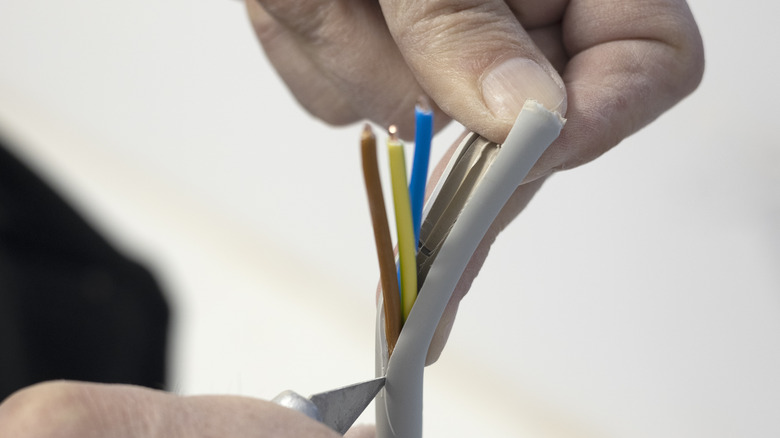This Hidden Boxcutter Feature Makes Stripping Wires A Breeze
We may receive a commission on purchases made from links.
Everyone knows how useful a boxcutter can be. With a thin, sharp blade and a smooth motion, it slices through packing tape and cardboard alike to open packages or break them down for recycling. Like many other tools, however, the boxcutter has hidden features. One such feature on single-blade, retractable boxcutters allows for far greater ease in wire stripping, eliminating the need for a separate tool — especially if you only ever do it occasionally. It's a small, semicircular indentation in the metal — as if a notch has been cut out — and it can be found positioned opposite the cutting edge on any simple retractable utility knife that uses a single, snap-off blade. This is a very basic boxcutter design, available for purchase at any home improvement store or big box retailer department, often for $2 or less.
Any home renovation project or industrious DIY hack that involves minor electrical work will likely require wire stripping — the process of removing the sheath from the ends so the wires can be connected directly to the appropriate source. It's a good skill to know how to do on at least a basic level, whether you plan electrical projects or simply need to troubleshoot in an emergency, and luckily, you can get it done with just your boxcutter.
The boxcutter trick
When you slide the blade of your utility knife out of its casing, you'll see a small indentation. It looks innocuous, but this is your wire-stripping secret weapon. Take the wire you need to strip and roll it gently along the sharp edge of the boxcutter blade, scoring the wire's sheath with a small groove all the way around. Then flip the boxcutter over and fit the notch firmly into the groove on the sheath.
Holding that end steady, pull the length of the wire away from the boxcutter. This will separate the plastic sheath you've secured from the metal wires inside, exposing them as you pull away. From that point, you can follow the appropriate steps to connect the wires as directed to your electrical source. However, remember to always shut off the primary power source before tinkering around to keep things safe.
Whether you're installing light fixtures, electrical outlets, or other hardwired items in your home, these basic skills should get you through. For more advanced wiring like coaxial cable, however, a professional wire cutter-crimper-stripper is preferred (possibly in addition to contacting an expert electrician). For projects requiring delicate wiring like telecommunications or fiber optic internet, a professional installer is likewise recommended. Please always take the proper precautions to ensure your electrical systems are installed correctly and never tackle a project you're unsure of.

